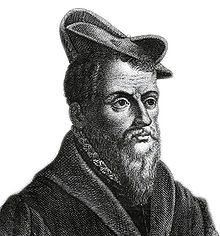Pierre Belon
Pierre Belon | |
|---|---|
 Pierre Belon | |
| Born | 1517 Souletière near Cérans-Foulletourte |
| Died | April 1564 Paris |
| Nationality | French |
| Scientific career | |
| Fields | |
Pierre Belon (1517–1564) was a French traveller, naturalist, writer and diplomat. Like many others of the Renaissance period, he studied and wrote on a range of topics including ichthyology, ornithology, botany, comparative anatomy, architecture and Egyptology. He is sometimes known as Pierre Belon du Mans, or, in the Latin in which his works appeared, as Petrus Bellonius Cenomanus. The Russian physiologist Ivan Pavlov (known for Pavlov's dogs) called him the "prophet of comparative anatomy".[1]
Life
Belon was born in 1517 at the hamlet of Souletière near
Belon was highly favoured both by
Works

Belon was typical of the
His first book was Histoire naturelle des estranges poissons (1551) and despite its title was a work mainly on the dolphin;[a] it did have woodcuts of some fishes, possibly the first among printed books in the West.[7]
His second book, De aquatilibus (in Latin, 1553) greatly expanded on the first and included a description of 110 species of fish, with illustrations; it was a work that laid the foundation of modern ichthyology.[8] Its French translation La nature et diversite des poissons (Paris, 1555) was followed by an edition of 1560, and the volume was reprinted in Frankfurt and Zurich. His works were translated by Carolus Clusius, and he was held in high authority by the Italian naturalist Ulisse Aldrovandi.
In his L'Histoire de la nature des oyseaux (1555) he included two figures of the skeletons of humans and birds, marking the homologous bones. This is widely seen as one of the earliest demonstrations of comparative anatomy.
Books

All of the following were first published in Paris.
- 1551: L'histoire naturelle des estranges poissons marins, avec la vraie peincture & description du Daulphin, & de plusieurs autres de son espece. Observee par Pierre Belon du Mans. A Paris. 1551.
- 1553: De aquatilibus. Libri duo Cum eiconibus ad vivam ipsorum effigiem, Quoad eius fieri potuit, expressis. Parisiis, 1553.
- 1555: La nature et diversite des poissons avec leurs pourtraicts representez au plus pres du naturel. Paris, 1555.[7]
- 1553: De arboribus Coniferis, Resiniferis aliisque semper virentibus..., a basic text on evergreens.
- De arboribus coniferis, resiniferis, aliis quoque nonnullis sempiterna fronde virentibus (in French). Paris: Guillaume Cavellat. 1553.
- 1553 De admirabili operi antiquorum et rerum suspiciendarum praestantia..., treating the funerary customs of Antiquity, in three volumes, of which separate titles head the second, on mummification (De medicato funere seu cadavere condito et lugubri defunctorum ejulatione) and third (De medicamentis nonnullis, servandi cadaveris vim obtinentibus).
- 1553: Les observationsde plusieurs singularitez et choses memorables trouvées en Grèce, Asie, Judée, Egypte, Arabie et autres pays étrangèrs.
- 1555: revised edition of the Observations; it was translated into Latin for an international readership by Clusius, 1589.
- Histoire de la nature des oyseaux (in French). Paris: Guillaume Cavellat. 1555.
- Portraits d'oyseaux, animaux, serpens, herbes, arbres, hommes et femmes, d'Arabie et Egypte (in French). Paris: Guillaume Cavellat. 1557.
-
Portraits d'oyseaux, animaux, serpens, herbes, arbres, hommes et femmes, d'Arabie et Egypte, 1557
Memorials
A genus in the plant family Gesneriaceae was named as Bellonia in his honour by Charles Plumier. A statue of Belon was erected at Le Mans in 1887.[1]
Explanatory notes
- ^ At that time the concept of fishes included all aquatic animals including mammals and the book included the first French illustration of a hippopotamus.[citation needed]
References
- Citations
- ^ ISBN 9780684101149.
- ^ a b c Morren, Édouard; Crié, Louis (1885). A la memoire de Pierre Belon, du Mans, 1517-1564 (in French). Liege : A la direction génŕale, Boverie.
- ^ Delaunay (1922), pp. 254.
- ^ Delaunay (1922), pp. 255.
- ^ Delaunay (1922), pp. 258.
- ^ Delaunay, P. (1926). Pierre Belon naturaliste. Le Mans: Imprimerie Monnoyer.
- ^ a b Gudger (1934), pp. 26–27.
- ^ Gudger (1934), pp. 27.
- Bibliography
- Gudger, E.W. (1934). "The five great naturalists of the sixteenth century: Belon, Rondelet, Salviani, Gesner and Aldrovandi: a chapter in the history of Ichthyology". Isis. 22 (1): 21–40. JSTOR 225322
- Delaunay, P. (1922). "L'aventureuse existence de Pierre Belon, du Mans. Chapitre I. La jeunesse de Pierre Belon". Revue du seizième siècle. 9 (3–4): 251–268.
External links
- Works by or about Pierre Belon at Internet Archive
- L'Histoire de la nature des oyseaux (1555)
- L'histoire naturelle des estranges poissons marins... (1551)
- Sketch of Pierre Belon
- Travels in the Levant: The Observations of Pierre Belon of Le Mans on Many Singularities and Memorable Things Found in Greece, Turkey, Judaea, Egypt, Arabia and Other Foreign Countries (1553). Translated into English by James Hogarth, with an Introduction by Alexandra Merle. Hardinge Simpole Publishers, 2012.

